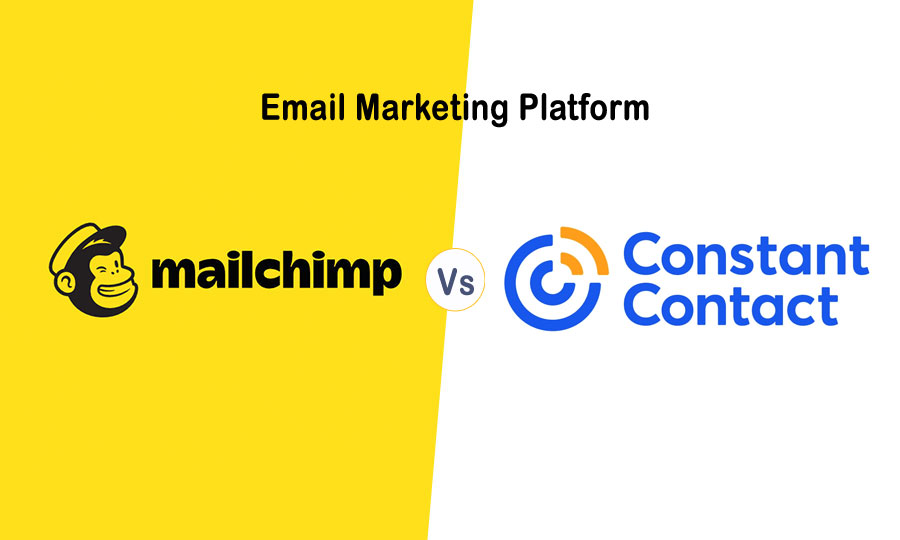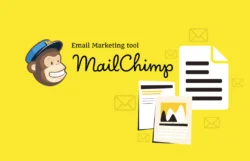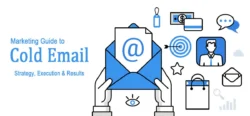So you’ve decided it’s time to up your marketing game and start building an email list. Smart move. Email marketing is one of the most effective ways to stay in touch with your customers, promote your business, and boost sales. Now you’ve got to choose an email service provider to help you create, send and track your email campaigns. Two of the biggest names in the business are MailChimp and Constant Contact. You’ve probably heard of them, but how do you know which one is right for you?
Table of Contents
- Email Marketing : Why You Need It
- Key Features of MailChimp and Constant Contact
- MailChimp vs Constant Contact – Features Comparison
- MailChimp vs Constant Contact – Customization Options
- MailChimp vs Constant Contact – Integrations and Connections Comparison
- MailChimp vs Constant Contact – List Management and Segmentation Comparison
- MailChimp vs Constant Contact – Analytics and Reporting Comparison
- Pricing: How Much Does MailChimp and Constant Contact Cost?
- Conclusion

Email Marketing : Why You Need It
Email marketing is one of the most effective ways to stay in touch with your customers and keep your business top of mind. Here are a few reasons why you need to start an email marketing campaign:
Staying in touch : Email is the perfect way to maintain an ongoing dialogue with your subscribers and build a long-term relationship with them. Send a regular newsletter with helpful tips, product updates, or blog post roundups. Your subscribers will appreciate you keeping them in the loop.
Driving sales : Email marketing is a proven driver of sales. In fact, for every $1 spent on email marketing, the average return on investment is $42! Send promotions for sales, new product launches or service offerings and watch your revenue grow.
Low cost : Email marketing is one of the most affordable ways to reach your audience. Once you’ve built your list, sending emails is virtually free. All you need is an email service provider like MailChimp or Constant Contact to help you create, send and track the results of your campaigns.
Targeting your messages : With email, you can segment your list based on interests, location, purchase history and more. Then send targeted messages to each group. This tailored approach will make your emails more relevant and effective.
Staying top of mind : When people subscribe to your email list, they’re expressing an interest in your company and products. Regular email contact helps to build familiarity and trust in your brand, so you remain at the forefront of their mind.
In summary, email marketing allows you to strengthen your customer relationships, boost sales, and raise brand awareness in an affordable, targeted way. It’s a strategy that no modern business can afford to ignore. What are you waiting for? Start building your email list today!
Key Features of MailChimp and Constant Contact
When choosing an email marketing platform, two of the top contenders are MailChimp and Constant Contact. Both offer useful features, but some key differences may make one better for your needs.
MailChimp is free for up to 500 subscribers and 1,000 emails per month. After that, paid plans start at $9.25/month. Constant Contact’s free trial lasts 14 days, then paid plans start at $12/month for up to 500 contacts and up to 5,000 emails send limit. So if budget is a concern, MailChimp probably has the edge.
MailChimp offers more advanced automation features like drip campaigns, allowing you to automatically send a series of emails to new subscribers. Constant Contact has basic automation but less advanced options. However, Constant Contact may be simpler to use if you’re new to email marketing.
Both services offer professional email templates to choose from, as well as the ability to create your own. MailChimp has a wider selection of free templates, while Constant Contact charges for some premium templates. But Constant Contact’s editor is a bit more intuitive if you want to design your own.
When it comes to reports and analytics, MailChimp provides more in-depth data on opens, clicks, geography, and more for free. Constant Contact offers basic reports for free, but charges for more advanced analytics.
Overall, MailChimp is better if you need advanced features and in-depth analytics on a budget. But Constant Contact has a simpler interface and may require less technical know-how to get started. The choice comes down to your needs, skills, and how much you can spend. With a little research, you can find the platform that suits you best.
MailChimp vs Constant Contact – Features Comparison
When it comes to ease of use, MailChimp and Constant Contact are quite comparable. Both platforms offer intuitive interfaces and drag-and-drop builders to help you create professional email campaigns with minimal hassle. However, there are a few differences to consider:
Learning Curve
MailChimp is generally considered slightly easier to pick up as a beginner. Their interface is clean and simple, with logical menus and minimal clutter. You can start creating basic email campaigns within minutes of signing up. Constant Contact has a steeper learning curve, with more advanced features that may seem overwhelming at first. However, Constant Contact does offer helpful video tutorials and guides to get you up to speed.
Design & Templates
When it comes to email marketing, a platform’s design and template options are crucial. Both MailChimp and Constant Contact offer stylish templates to choose from, but there are some key differences to consider.
Both services provide a wide selection of mobile-friendly templates to choose from. MailChimp offers a few more options, with templates for newsletters, product promotions, events, and more. The templates are also more visually appealing. That said, Constant Contact’s templates are still professional and eye-catching. With either platform, you can customise the templates by changing fonts, colours, and adding your logo and images. But MailChimp’s drag-and-drop editor may feel more intuitive, especially for beginners.
MailChimp currently offers around 100 free email templates in a variety of styles. These include basic templates for newsletters, product updates, and promotions as well as more niche templates for events, surveys, and e-commerce. Constant Contact also provides 100+ mobile-friendly templates for most standard email types. However, their selection may be more limited if you’re on their most basic plan.
Drag-and-Drop Editor
MailChimp and Constant Contact both have an intuitive drag-and-drop editor, allowing you to add and arrange elements with just a click and drag of your mouse. You can include:
- Images
- Text boxes
- Buttons
- Dividers
- Social media icons
- And more
The editor makes it simple to create great-looking emails, even if you have no design experience. You have full control over the look and layout.
Overall, MailChimp does have a slight advantage when it comes to ease of use, especially for beginners. However, Constant Contact is still an accessible platform, and its advanced features may appeal to more experienced users. Either service will allow you to create and send professional email newsletters with minimal hassle. The choice comes down to your specific needs and level of experience.
Mobile-Friendliness
In today’s world, if your emails don’t display well on mobile devices, you’ll lose a huge portion of your audience. Both MailChimp and Constant Contact optimise their templates for mobile viewing.
MailChimp’s templates are responsive, automatically adjusting to the screen size. Constant Contact also has responsive templates, but with their cheaper plans you have to pay extra for mobile-optimised and responsive template options.
A/B Testing
If you want to experiment with different email designs to see which ones resonate most with your subscribers, A/B testing is essential.
MailChimp allows you to set up A/B tests for subject lines, content, layouts, and calls-to-action to determine the highest-performing versions. With some Constant Contact plans, you have access to basic A/B testing for subject lines and content. More advanced testing of templates and layouts requires an upgrade.
In the end, while both platforms offer eye-catching templates, MailChimp comes out slightly ahead with their selection, customization options, and built-in A/B testing. But for a smaller business on a tight budget, Constant Contact’s templates may suit your needs just fine. The choice comes down to how much design flexibility and optimization you require.
MailChimp vs Constant Contact – Customization Options
When it comes to customising your email campaigns, both MailChimp and Constant Contact offer a lot of options, but there are some key differences to consider.
Templates
MailChimp provides a wide selection of free, customizable templates to choose from. You can select templates for newsletters, product updates, event promotions, and more. Their drag-and-drop editor makes it easy to change fonts, colours, and add your own images and content.
Constant Contact also has a template library, but with fewer free options. However, their paid plans provide access to premium templates as well as the option to save your own customised templates for reuse. For both services, you can build your emails from scratch if you prefer.
Branding
Want your emails to match your company’s brand? MailChimp lets you upload your logo, brand colours, and fonts to apply to all your emails and campaigns. They even have a “brand asset” feature to automatically apply your brand elements each time you create a new email.
With Constant Contact, you’ll need to manually customise each email to match your brand. They don’t have a way to save your brand elements for automatic application to new emails. For a consistent brand experience across all your campaigns, MailChimp has a clear advantage.
Automation
If you want to send automated welcome emails or product recommendations based on subscriber actions, MailChimp is a great choice. Their automation features allow you to set up triggered email workflows with ease. Constant Contact’s automation options are more limited, so you may need an additional service to handle more advanced email automation.
In the end, while both platforms offer a lot of flexibility, MailChimp comes out ahead for customization with more templates, robust branding features, and powerful automation options. For a small business on a budget, MailChimp is an affordable solution that can meet all your email marketing needs. If you need additional features like online surveys or events management, Constant Contact may be better suited with their all-in-one marketing platform.
MailChimp vs Constant Contact – Integrations and Connections Comparison
When it comes to integrations and connections, both MailChimp and Constant Contact have a lot to offer. However, there are some key differences to consider based on your needs.
Email Marketing Integrations
Both platforms provide seamless integration with major ecommerce platforms like Shopify, WooCommerce, and Magento to sync email lists and automate email campaigns. They also integrate with popular CRMs such as Salesforce, HubSpot, and Zoho to automatically add new contacts to your email list.
Social Media Integrations
Do you want to promote your email campaigns on social media or segment contacts based on their social profiles? MailChimp integrates with Facebook, Instagram, and Twitter so you can easily share your email content on social media and create targeted email lists based on your contacts’ social data. While Constant Contact does offer some basic social sharing features, their social media integrations are not as robust.
Analytics and Reporting Integrations
To gain further insights into your email marketing performance, consider integrations with analytics and reporting tools. MailChimp provides native integrations with Google Analytics, Google Ads, and Facebook Pixel so you can track email campaign attribution and see how your emails influence your contacts’ behaviour on your website and social media platforms. Constant Contact does offer Google Analytics integration, but lacks some of the other in-depth integrations that MailChimp provides.
Landing Page and Form Builders
Creating dedicated landing pages and contact forms for your email list growth efforts is a must. MailChimp provides simple drag-and-drop landing page and form builders so you can easily build custom signup forms, landing pages, and surveys without any coding required. While Constant Contact does have basic landing page and form building features, their options are not as intuitive or customizable as what MailChimp offers.
In summary, if you’re looking for a platform with extensive integration possibilities to maximise your email marketing and better understand your audience, MailChimp is likely the better choice. However, for smaller businesses with more basic needs, Constant Contact should work just fine. The integrations and connections available come down to how much functionality and data you need to improve your email marketing results.
MailChimp vs Constant Contact – List Management and Segmentation Comparison
When it comes to managing your email lists and segmenting your subscribers, MailChimp and Constant Contact offer some similar features but also differ in a few key ways.
List organisation
Both platforms allow you to organise contacts into lists based on categories like location, interest, purchase history, etc. You can then send targeted campaigns to specific lists. MailChimp offers more advanced options for sorting and filtering your lists. With Constant Contact, you’re limited to basic alphabetical sorting.
List segmentation
Segmenting your lists into smaller groups lets you send the most relevant content to your subscribers. MailChimp provides robust segmentation tools, allowing you to divide lists into groups based on multiple factors like location, interests, and past email engagement. Constant Contact only allows you to segment by a single factor at a time.
Automation
MailChimp is better equipped for setting up automated email workflows and drip campaigns. You can create sequences to automatically add or remove subscribers from lists based on their actions. Constant Contact lacks advanced automation features, so building complex drip campaigns would require manually updating lists and sending emails.
List hygiene
Both services provide tools for keeping your email lists clean and up-to-date, including detecting and removing inactive subscribers, spam traps, and abuse reports. MailChimp’s list hygiene features are more comprehensive, offering additional options like unsubscribing inactive subscribers, detecting role-based email addresses, and allowing subscribers to update their own profiles.
In summary, while Constant Contact can work for basic email marketing needs, MailChimp is superior for advanced list management and segmentation. If using targeted email campaigns and automation to engage your subscribers in a personalised way is important to you, MailChimp is probably your best choice.
MailChimp vs Constant Contact – Analytics and Reporting Comparison
When it comes to analytics and reporting, MailChimp and Constant Contact offer similar core features to help you understand how your email campaigns are performing. However, there are some key differences to consider.
Campaign Analytics
Both platforms provide stats on open rates, click-through rates, bounces, and unsubscribes to measure the effectiveness of your campaigns. MailChimp’s analytics dashboard is more visually appealing, with interactive charts and graphs that allow you to filter data by date range, campaign type, and other factors. Constant Contact does offer campaign summaries and reports you can download, but the analytics interface is more basic.
A/B Testing
If you want to optimise your email marketing by testing different subject lines, content, or layouts, MailChimp has a built-in A/B testing tool. You can easily create two versions of an email and send each version to a portion of your list to see which one performs better. Constant Contact does not currently offer A/B testing capabilities.
Google Analytics Integration
MailChimp integrates directly with Google Analytics, allowing you to gain insights into subscriber behaviour beyond just opens and clicks. You can see which links subscribers clicked, how long they spent reading your email, and more. With Constant Contact, you’ll need to instal additional tracking to get this level of data.
Custom Reports
Both services allow you to create customised reports to view metrics that matter most to you. In MailChimp, you can build reports with different segments, filters, and comparisons to analyse your email marketing performance over time. Constant Contact also provides the ability to build custom reports, though with fewer configuration options.
Overall, while Constant Contact covers the basics, MailChimp provides significantly more advanced analytics and reporting features for gaining actionable insights from your email marketing data. For small businesses, MailChimp should meet your needs, but larger companies may benefit more from Constant Contact’s enterprise-level analytics and reporting capabilities.
Pricing: How Much Does MailChimp and Constant Contact Cost?
When it comes to pricing, MailChimp and Constant Contact offer similar options but differ in the details. Both platforms provide free trials and paid subscription plans for small to large businesses. Let’s break down the costs to help determine which service suits your needs and budget.
MailChimp Pricing
MailChimp offers a free plan for up to 500 subscribers and 1,000 emails per month. Their paid plans start at $9.25/month for up 500 contacts and 5,000 emails. Prices increase from there for larger lists and higher volumes. MailChimp doesn’t charge you for inactive subscribers or require annual contracts. You can pay month-to-month and cancel anytime.
Constant Contact Pricing
Constant Contact’s entry-level paid plan is $12/month for up to 500 contacts and you can send up to 5,000 emails. Their prices are a bit higher than MailChimp’s for comparable features and audience sizes. However, Constant Contact does offer non-profit discounts of up to 30% off. They also provide the option to pay annually for a 15% lower effective monthly rate. If budget is a concern, the annual billing may save you some money over time.
Both services provide useful tools for creating email campaigns, segments, automations, and reports to grow your business. While Constant Contact charges a premium, they do offer phone support and non-profit discounts as added value. For most small businesses, MailChimp should suit your needs at a lower cost. However, if you need the additional features and support offered by Constant Contact, the higher fees may be worthwhile for your organisation.
In summary, you can’t go wrong with either platform. But when factoring in list size, email volume, available features, and budget, one service may make more financial sense for your email marketing needs over the other. Evaluate your options carefully based on what’s most important for your business. The good news is you can easily switch between the two services if you start with one and find the other is a better fit down the road.
Conclusion
So there you have it, a quick overview of MailChimp and Constant Contact, two of the biggest names in email marketing. At the end of the day, you need to go with what feels right for your business and your budget. If you’re just getting started and want an easy-to-use platform with room to grow, MailChimp is probably your best bet. If you need advanced automation and analytics from day one, Constant Contact may be worth the investment. The good news is you really can’t go wrong with either of these tools. So take a free trial, see which one sparks your creativity, and then get out there and start connecting with your customers. The world is waiting to hear from you!







